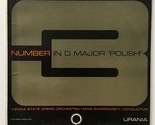Tchaikovsky: Symphony Number 3 In D Major 'Polish' LP Vinyl Record Album
Ships from
United States

Don't miss out on this item!
There is only 1 left in stock.
Shipping options
Seller handling time is 1-3 business days Details
This reflects the seller's handling time and may not include time spent in transit.
If you have questions about shipping, please contact the seller.
£24.18 to United Kingdom
Ships from
United States

Offer policy
OBO - Seller accepts offers on this item.
Details
You can make your offer during the checkout process as long as you do not live in a state where marketplace facilitator tax laws exist.
Check your state.
Return policy
Refunds available: See booth/item description for details
Payment options
PayPal accepted
PayPal Credit accepted
Venmo accepted
PayPal, MasterCard, Visa, Discover, and American Express accepted
Maestro accepted
Amazon Pay accepted
Nuvei accepted
Shipping options
Seller handling time is 1-3 business days Details
This reflects the seller's handling time and may not include time spent in transit.
If you have questions about shipping, please contact the seller.
£24.18 to United Kingdom
Ships from
United States

Offer policy
OBO - Seller accepts offers on this item.
Details
You can make your offer during the checkout process as long as you do not live in a state where marketplace facilitator tax laws exist.
Check your state.
Return policy
Refunds available: See booth/item description for details
Payment options
PayPal accepted
PayPal Credit accepted
Venmo accepted
PayPal, MasterCard, Visa, Discover, and American Express accepted
Maestro accepted
Amazon Pay accepted
Nuvei accepted
Item traits
| Category: |
Vinyl Records
|
| Quantity Available: |
Only one in stock, order soon
|
| Condition: |
Used
|
| Style: |
Classical Sonata, Classical Toccata, Pop 1960s, World Music Italy
|
| Speed: |
33 RPM
|
| Record Size: |
12"
|
| Duration: |
LP
|
| Record Grading: |
Very Good Plus (VG+)
|
| Sleeve Grading: |
Very Good Plus (VG+)
|
| Special Attributes: |
1st Edition
|
| Record Label: |
CoronetUrania Records
|
| Release Year: |
1964
|
| Country/Region of Manufacture: |
United States
|
Listing details
|
Seller policies:
|
View seller policies
|
|
Shipping discount:
|
Items after first shipped at flat $1.00
|
|
Posted for sale:
|
More than a week ago
|
|
Item number:
|
842998000
|
Cover is VG++ (shelf wear)
Record is VG++ (looks barely played)
Labels are clean
Visually Graded
Tracklist
Side 1
1 Introduzione E Allegro: Moderato Assai (Tempo Di Marcia Funebre) - Allegro Brillante
2 Alla Tedescha: Allegro Moderato E Semplice
Side 2
1 Andante Elegiaco
2 Scherzo: Allegro Vivo
3 Finale: Allegro Con Fuoco (Tempo Di Polacca) - Presto
Pyotr Ilyich Tchaikovsky's Symphony No. 3 in D major, Op. 29, was written in 1875. He began it at Vladimir Shilovsky's estate at Ussovo on 5 June and finished on 1 August at Verbovka. Dedicated to Shilovsky, the work is unique in Tchaikovsky's symphonic output in two ways: it is the only one of his seven symphonies (including the unnumbered Manfred Symphony) in a major key (discounting the unfinished Symphony in E? major); and it is the only one to contain five movements (an additional Alla tedesca movement occurs between the opening movement and the slow movement).
The symphony was premiered in Moscow on 19 November 1875, under the baton of Nikolai Rubinstein, at the first concert of the Russian Music Society's season. It had its St. Petersburg premiere on 24 January 1876, under Eduard Nápravník. Its first performance outside Russia was on 8 February 1879, at a concert of the New York Philharmonic Society.
Its first performance in the United Kingdom was at the Crystal Palace in 1899, conducted by Sir August Manns, who seems to have been the first to refer to it as the "Polish Symphony", in reference to the recurring Polish dance rhythms prominent in the symphony's final movement. Several musicologists, including David Brown and Francis Maes, consider this name a faux pas. Western listeners, conditioned by Chopin's use of the polonaise as a symbol of Polish independence, interpreted Tchaikovsky's use of the same dance likewise; actually, in Tsarist Russia it was musical code for the Romanov dynasty and, by extension, Russian imperialism.
The symphony was used by George Balanchine as the score for the Diamonds section of his full length 1967 ballet Jewels, omitting the opening movement.
